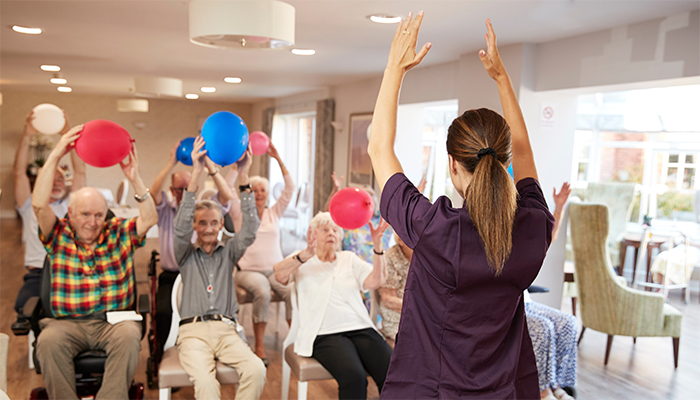Your Eldercare Compass
Helpful tips for family caregivers
September/October 2024
Chronic inflammation is important to address at any age, but it becomes a bigger issue the older we get. This month we look at ways to both calm inflammation and help the body return to balance. This is information everyone can benefit from! Next, we discuss the evolution of assisted living over the years and share insights to help decide if it’s a good move for your relative. In our last article, we tackle the issue of suicide among older adults. It’s a tough topic, but one that needs to be talked about.
Reducing and resolving chronic inflammation
Inflammation is the way the immune system attacks bacteria, viruses, and any perceived foreign agent in the body. It’s crucial when we need it! Think of inflammation as sending soldiers onto a battlefield. You need to fight the invaders, but also clean up afterward so life can get back to normal. As we age, our body’s ability to shut down an attack gets compromised. We don’t fight the battle as well. That means the inflammation doesn’t resolve. The body has not cleared out dead cells and other debris from the fight so new tissue can be rebuilt. Without resolution, the immune response keeps going. It’s harder for other cells to return to normal function.
To reduce chronic inflammation. The first step is to quit activities that provoke inflammatory response. Smoking and alcohol consumption, for instance, create unnecessary threats. Stress reduction techniques such as yoga or mindfulness contribute to health because they reduce the signals that the body is under attack. Weight loss is often recommended because fat cells produce cytokines, some of the warrior cells of inflammation.
Actions to support resolution (the cleanup)
- At least moderate activity 30 minutes a day, five days a week, helps flush the system and enhances DNA repair.
- Seven to eight hours of sleep a night gives the brain the down time it needs to tidy up and remove dead cells and the byproducts of inflammation.
Anti-inflammatory diet. While dietary changes may not eliminate chronic inflammation by themselves, they do support a healthy, resilient immune system.
- Avoid these foods. They tend to promote an inflammatory response. Trans fats. Fried foods. Sugary drinks or foods. White bread and pastries. Cured meats with nitrates (deli meats, hot dogs). All highly processed foods.
- Eat lots of these foods. They help get rid of dead cells and debris. Whole grains. High-fiber vegetables such as kale, spinach, and broccoli. Legumes such as beans and lentils. Anti-oxidant fruits such as blueberries, strawberries, and cherries. Fatty fish such as salmon and sardines. Nuts and seeds. Good fats from olives, olive oil, and avocados.
The Mediterranean diet and the DASH diet are examples of dietary practices that help reduce inflammation.
Return to topIs assisted living a good fit?
The original idea of “assisted living” was to give generally healthy elders a social option to offset the isolation of living alone. They were not intended to be medical facilities.
But things have changed in the 40 years since inception! Now, 41% of residents have dementia or moderate-to-severe cognitive impairment. One out of ten has a serious mental illness. More than half are 85 or older.
Assisted living communities are also experiencing staff shortages and high turnover. With a needier population, employees need far more specialized training than they did in the past. For dementia care, certainly. Also for infection control, as came to light during the pandemic. And end-of-life care. It’s hard to know which communities have adequately trained staff.
Choosing an assisted living facility. If an assisted living facility seems like a good fit for your relative, your next step may be a Google search for available options. Placement agencies will offer “free” referrals. These agencies receive a fee from the facilities for bringing in a new client. They may only show you those that provide the highest fee. For objective recommendations, hire an Aging Life Care Manager. They will assess your relative and give you suggestions based on the support your loved one requires and the facilities best suited to meet those needs. Also the ones with the lowest staff turnover and those that fit your budget.
When you tour a facility, be sure to talk to the frontline staff. Ask how long they’ve worked there and what they like about their jobs. Also ask about staff training offered through the facility. Look for clues in their body language that suggest their level of comfort about speaking freely.
Recognize that this may not be your relative’s last move. The median stay is 22 months. About 60% of residents leave to go to nursing homes. Others move in with family or move to a different facility.
Return to topSuicide and older adults
While older adults make up roughly 17% of the population, they constitute 22% of deaths by suicide. There are many reasons older adults might lean toward death: Poor health, chronic pain, loss of a spouse, loneliness, departure from working life, loss of independence, cognitive impairment.
Warning signs. Any mention of wanting to die should be taken seriously. Also watch for depression. Withdrawal from social activities. Expressions of hopelessness (“Why bother?”) or worthlessness (“I’m just a burden”). Increased use of alcohol or drugs. Poor self-care and hygiene. Giving away belongings. Hurriedly changing a will or trust.
What you can do
- Ask if they are considering suicide. Asking will not prompt them to act. By asking, you demonstrate that they matter. Talk with them. Acknowledge their emotional pain. Find out more about their issues.
- Keep them safe. Ask if they have a plan. Do they have a timetable? Do they have access to their planned method? The more detailed the plan, the more likely they are to act. Ask them to promise you they won’t do anything for 24 hours.
- Be present. Gently ask how you might help. If you can ask them in person, great. If not, video conferencing and phone calls let them know they aren’t alone. Don’t promise things you cannot do.
- Assemble support. You can text or call the 24-hour Suicide & Crisis Lifeline at 988 to get advice. Also, help your relative identify others they can reach out to (a friend, counselor or faith leader, or the 988 Lifeline). The Suicide & Crisis Lifeline does not automatically send out first responders. They assess the urgency of the situation and work to diffuse the pain.
- Follow up. Call your loved one the next day to see how they are doing. Implement the suggestions of the 988 professionals. Encourage your relative to get professional support.




